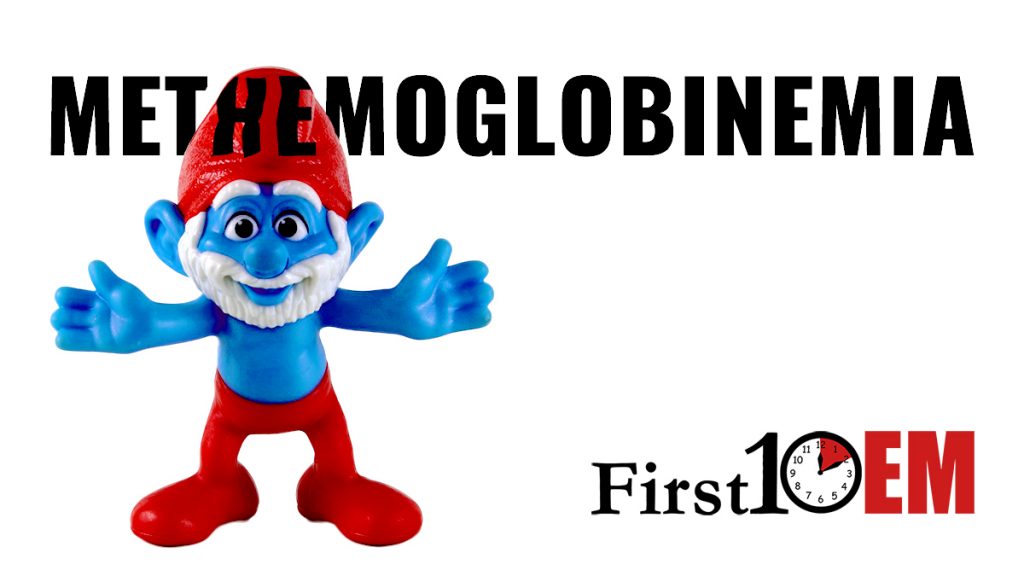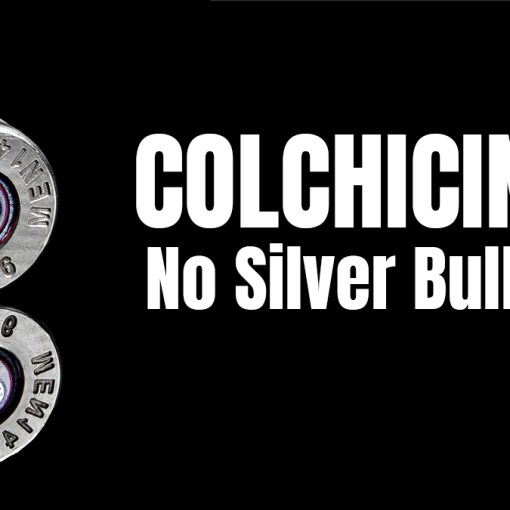A 45 year old brought in by EMS after being found unconscious and cyanotic. She has Celiac disease, and was started on dapsone for dermatitis herpetiformis yesterday. She doesn’t have any other health problems, and aside from the rash, has been healthy recently. She is afebrile and her blood glucose is normal. She looks blue, and her oxygen saturation is reading 85% despite the nonrebreather placed by EMS. Her working of breathing appears normal and her lung exam is unremarkable. The nurse doing blood work notes that her blood looks funny – a chocolate brown colour. Could this be methemoglobinemia?
My approach
Start with the ABCs. Altered mental status may require airway intervention, and the oxygen saturation will read as low, so patients all warrant high flow oxygen through a non-rebreather during the initial assessment and stabilization.
Make the diagnosis. Unlike anaphylaxis or severe asthma, where the patient often comes in and tells us the diagnosis, the most difficult part of treating methemoglobinemia is likely recognizing that you are treating methemoglobinemia. In general, the signs of methemoglobinemia are nonspecific, but are in keeping with what you would expect with a relative anemia or hypoxia: dizziness, fatigue, headache, dyspnea, and – at higher levels – coma, metabolic acidosis, and dysrhythmias. (Skold 2011; Katz 2019)
The key signs of methemoglobinemia are cyanosis and an oxygen saturation in the low to mid 80s. One of the key clues that you might be dealing with methemoglobinemia is an oxygen saturation in the 80s that does not improve with high flow supplemental oxygen. Another clue is the presence of cyanosis in a patient with an oxygen saturation in the 80s, because we don’t usually notice clinical cyanosis until the oxygen saturation falls below 60%. (Cyanosis out of proportion to the oxygen saturation.) (Skold 2011) Finally, the nurse might make the diagnosis for you by mentioning the funny coloured “chocolate brown” blood. If you aren’t sure, you can place some blood on a piece of gauze. Normally desaturated blood will absorb oxygen from the air and become red, whereas methemoglobinemia will not. (Skold 2011; Farkas 2019)
For a definitive diagnosis, send a blood gas for CO-oximetry. In many hospitals, this is a send out test, and empiric treatment is the best approach. Alternatively, an ABG with a high PaO2 in the setting of a low pulse ox is enough to indicate haemoglobinopathy. (Skold 2011)
KEY QUESTION: Does this patient have G6PD defiency? If so, methylene blue may be contra-indicated. (Skold 2011) See below.
For all other patients, if there are significant symptoms or risk from decreased oxygen delivery, give methylene blue 1-2 mg/kg infused over 5 minutes. (Farkas 2019; Katz 2019) (Usually, treatment is required for levels >20%.) (Skold 2011; Prchal 2018) Clinical improvement should occur within minutes. If there is no improvement, you can give another 1mg/kg dose (although at this point, I would definitely involve a toxicologist, if you haven’t already).
In cases where the ingested agent has a longer half-life than methylene blue, you might see a rebound. (Skold 2011) Occasionally, a methylene blue infusion (0.1mg/kg/hr) is required. You can expect to see toxic effects from methylene blue once you get to 7 mg/kg. (Skold 2011; Farkas 2019)
Your toxicologist might recommend adjuncts such as riboflavin or intravenous vitamin C. (Farkas 2019) In the case of a longer acting oral ingestion, such as dapsone, they may also suggest multi-dose activated charcoal.
If the patient is very sick and not responding to methylene blue, the final option would be an exchange transfusion.
Special case: Treating the patient with G6PD deficiency
Call a toxicologist. These patients are complex, and if at all possible, care should be guided by an expert.
The problem is that our antidote – methylene blue – causes hemolysis in G6PD. When you are already having oxygen delivery problems, compounding that with hemolysis is a bad plan. This is compounded by the fact that methylene blue requires the G6PD enzyme to work, so not only are you causing potential harm, you aren’t helping the patient. (Skold 2011)
Recommendations vary widely. If the patient is not clinically unwell, observation might be the best option. The adjuncts mentioned above – intravenous vitamin C and riboflavin – might be reasonable options for mildly ill patients, but take too long from someone who is critically ill. For sick patients, the best option may still be methylene blue, but I would start with a lower dose in consultation with a toxicologist.
Notes
I can never remember the difference between ferrous and ferric. It really doesn’t matter that much clinically. All that you have to remember is that in methemoglobinemia the iron has been converted into the form that cannot transport oxygen. For the pedantic, Hb is in the ferrous state (2+) normally, and converts to the ferric (3+) when oxygen attaches. There are a number of oxidizing substances that steal an electron from ferrous (2+) iron and convert it to ferric (3+), which prevents the transport of oxygen. This is methemoglobinemia. (Skold; Farkas 2019)
Common causes:
- Local anesthetics (benzocaine, prilocaine, tetracaine, lidocaine)
- Nitrates (nitroglycerine, nitroprusside, inhaled nitric oxide, amyl nitrate)
- Antibiotics (dapsone, rifampin, sulfonamides, antimalarials)
- And, of course, a long list of “other medications” (metoclopramide, phenazopyridine, rasburicase)
- And some environmental/occupational exposures (fertilizers, weed killers, dyes, paints, rubber, fava beans, ginkgo biloba)
Even in the absence of G6PD, there is likely to be hemolysis from oxidative stress. Clinically, this is important because it means you can’t trust an improvement in cyanosis to mean and improvement in overall status. Cyanosis is based on the absolute amount of methemoglobinemia. If you have a normal hemoglobin (140 mg/dL), a methemoglobinemia level of 20% will be enough to make you look blue. However, if you get significant hemolysis, and your hemoglobin level falls to 100 mg/dL, the same 20% level may not be enough to cause cyanosis.
Methylene blue is a MAO inhibitor. We don’t use these drugs very often anymore, because of the many interactions, but remember that serotonin syndrome is possible in patients taking serotonergic agents, such as SSRIs. This should not stop you from giving methylene blue – the risk from methemoglobinemia definitely outweighs the risk from serotonin syndrome.
Other FOAMed Resources
Internet Book of Critical Care: Methemoglobinemia
Tox and Hound – Fellow Friday – Methylene Blue Infusions
emDocs: Tox Card: Methemoglobinemia
References
Farkas J.(2019) “Methemoglobinemia”. In: Farkas J. The Internet Book of Critical Care. 2019. Available at: https://emcrit.org/ibcc/methemoglobinemia/
Katz Kenneth, Amaducci Alexandra. Carbon Monoxide, Cyanide, Methemoglobinemia Poisoning. In: Mattu A and Swadron S, ed. CorePendium. Burbank, CA: CorePendium, LLC. https://www.emrap.org/corependium/chapter/recHKmNZcdbGz2cGA/Carbon-Monoxide-Cyanide-Methemoglobinemia-Poisoning. Updated November 7, 2019. Accessed November 7, 2019.
Prchal, JT. (2018) Clinical features, diagnosis, and treatment of methemoglobinemia. In: UpToDate, Mahoney DH and Burns MM (Eds), UpToDate, Waltham, MA
Price DP. Methemoglobin Inducers. In: Hoffman RS, Howland M, Lewin NA, Nelson LS, Goldfrank LR. eds. Goldfrank’s Toxicologic Emergencies, 10e New York, NY: McGraw-Hill; 2015.
Skold A, Cosco DL, Klein R. Methemoglobinemia Southern Medical Journal. 2011; 104(11):757-761. PMID: 22024786
Morgenstern, J. Methemoglobinemia, First10EM, August 31, 2020. Available at:
https://doi.org/10.51684/FIRS.21344






One thought on “Methemoglobinemia”